Question According tne Ghana Statistical Service data collected in 2020 shows that, 5% of individuals living within the city move to the rural areas during a one-year period, while 4% of individuals living in the rural areas move to the city a one- year period. Assuming that, this process is modeled by a Markov process with two states: city and rural areas a) i. Prepare the matrix of transition probabilities ii. Compute the steady-state probabilities. iii. In a particular District, 40% of the population lives in the city, and 60% of the population lives in the suburbs. What population changes do your steady-state probabilities project for this metropolitan area? "
Question According tne Ghana Statistical Service data collected in 2020 shows that, 5% of individuals living within the city move to the rural areas during a one-year period, while 4% of individuals living in the rural areas move to the city a one- year period. Assuming that, this process is modeled by a Markov process with two states: city and rural areas a) i. Prepare the matrix of transition probabilities ii. Compute the steady-state probabilities. iii. In a particular District, 40% of the population lives in the city, and 60% of the population lives in the suburbs. What population changes do your steady-state probabilities project for this metropolitan area? "
Elementary Linear Algebra (MindTap Course List)
8th Edition
ISBN:9781305658004
Author:Ron Larson
Publisher:Ron Larson
Chapter2: Matrices
Section2.5: Markov Chain
Problem 55E
Related questions
Topic Video
Question
Q5

Transcribed Image Text:Question
According tne Ghana Statistical Service data collected in 2020 shows that, 5%
of individuals living within the city move to the rural areas during a one-year
period, while 4% of individuals living in the rural areas move to the city a one-
year period. Assuming that, this process is modeled by a Markov process with
two states: city and rural areas
a) i. Prepare the matrix of transition probabilities
ii. Compute the steady-state probabilities.
iii. Ina particular District, 40% of the population lives in the city, and 60% of
the population lives in the suburbs. What population changes do your
steady-state probabilities project for this metropolitan area? '
Expert Solution
This question has been solved!
Explore an expertly crafted, step-by-step solution for a thorough understanding of key concepts.
This is a popular solution!
Trending now
This is a popular solution!
Step by step
Solved in 2 steps with 1 images

Knowledge Booster
Learn more about
Need a deep-dive on the concept behind this application? Look no further. Learn more about this topic, probability and related others by exploring similar questions and additional content below.Recommended textbooks for you

Elementary Linear Algebra (MindTap Course List)
Algebra
ISBN:
9781305658004
Author:
Ron Larson
Publisher:
Cengage Learning

Linear Algebra: A Modern Introduction
Algebra
ISBN:
9781285463247
Author:
David Poole
Publisher:
Cengage Learning

Elementary Linear Algebra (MindTap Course List)
Algebra
ISBN:
9781305658004
Author:
Ron Larson
Publisher:
Cengage Learning

Linear Algebra: A Modern Introduction
Algebra
ISBN:
9781285463247
Author:
David Poole
Publisher:
Cengage Learning